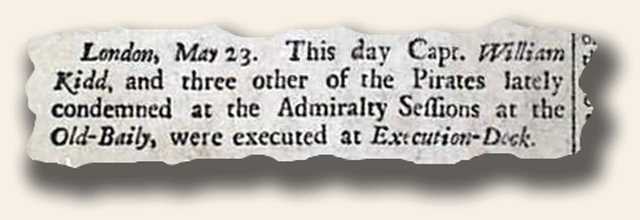Dateline: your town
If you work in the media, you

probably know what a dateline is. But exactly what is a dateline, and where's the "date" part in a dateline?
For reasons that aren't entirely clear or convincing to me, for centuries newspapers would place a location and a date at the beginning of a story (like the very old one above) that takes place outside of the publication's circulation area. For example, a newspaper in New York City might have used for a dateline something like this at the beginning of the text of a story, before the first sentence:
PARIS, June 24 --
The format requires the city in all caps, then the state or nation after it lowercase (if used; Paris does not require such, as I will explain later).
And now you see where the date part comes from.
But why was the date put there in the first place? Wouldn't the context of the story make it clear when the action is taking place, such as references to last week, today, yesterday, June 17, etc.? That's certainly the case for any article you read in a newspaper nowadays.
Perhaps it stems from the era of multiple newspaper editions each day and the need to make absolutely clear what day a story took place. That's the reason why the newspaper hawker on the street would utter
 the famous "extra! extra!" -- before the advent of immediate news from TV, radio and the Internet, newspapers often would print an "extra" edition (or several extras) to rush into publication some breaking news they didn't want to wait until the next day to publish. To entice readers to buy a new edition, the paper would put out an "extra" and the hawkers would announce the latest news in the extra with their loud sales pitch.
the famous "extra! extra!" -- before the advent of immediate news from TV, radio and the Internet, newspapers often would print an "extra" edition (or several extras) to rush into publication some breaking news they didn't want to wait until the next day to publish. To entice readers to buy a new edition, the paper would put out an "extra" and the hawkers would announce the latest news in the extra with their loud sales pitch.Or perhaps it came from weekly/monthly editions and the desire to let the reader know which day of the previous week/month the story took place. But again, wouldn't the story be able to make that clear without such a crutch? I certainly don't need a date on the stories I read in the free community weekly that is thrown on our driveway every Wednesday.
I don't know the answer, and a brief Internet search offered little help on the origin of datelines. But that doesn't matter. The important thing today is to grasp the proper use of datelines when it comes to locations, vital because it applies not just to the dateline at the beginning of a story but how to use a location in the story itself. This will make sense in a moment.
I'm not aware of any major newspaper in the U.S. that still uses the actual date in a dateline. But you might be surprised to learn that as recently as late 2007, The New York Times continued that long-outdated practice. Why it took The Times so long to come to its senses is a mystery to me.
What made that practice particularly dopey was the paper's insistence on treating every story as if it were happening right at that moment, as if typing "June 24" magically whisked the reader
That's ridiculously confusing to readers, who then might see "today," "yesterday" and "tomorrow" sprinkled all over the newspaper in various articles with different dates in the datelines, with the newspaper very wrongly figuring you the reader immediately will connect the dots from the obscure date printed in the dateline and will know today doesn't really mean today in several places in the newspaper. Huh?
Talk about needlessly confusing readers.
Thankfully, all we need concern ourselves with is the location in datelines. The guidance for most newspapers is Associated Press style, followed by the newspaper's own individual style guides and the general rule dictating how to use datelines for stories that take place in the same state that the newspaper is published in.
This is important because it dictates how to use such locations in the story, not just the dateline.
For example, AP has compiled a list of U.S. and international cities that "stand alone" in datelines, meaning the city alone is sufficient to identify a location. Stories put on the AP list are considered so familiar and famous that no normal reader would have any problem recognizing them using the city by itself. And remember, brevity is essential in newspapers because of space limitations, so any chance to identify someplace using fewer words is good.
For example, on AP's list of datelines are such places as New York, Los Angeles, Chicago, Paris, Moscow, London, Stockholm and Rio de Janeiro. So for the dateline as well as all uses of the city in text, you can write London and not the longer London, England. Of course there are other cities in the world named London, but the thinking is that unless a story specifies otherwise (such as writing London, Calif.), it is safe to assume all references to London refer to the famous English capital.
Washington rightly
Yet even though this is clearly the rule, at every newspaper I have worked at as an editor, I find that reporters, editors and copy editors are forever wrongly putting ", D.C." after Washington. They somehow think readers need this clarification, even though the style we use (AP) clearly thinks there is no such confusion. Trust AP style and just use Washington 95 percent of the time.
There are rare exceptions, of course, but isn't it clear, for example, that when we write "in the 50 states plus Washington" that Washington is the capital and not the state, obviously one of the aforementioned 50 states already?
Newspapers often also have their own individual list of datelines. The New York Daily News, for example, felt that for its readers Newark, Trenton and Jersey City were familiar enough cities in nearby New Jersey that the state did not need to be included in any references to those locations. It also felt, unlike AP, that cities like Tucson (in Arizona), Ankara (in Turkey) and Nashville (in Tennessee) also were familiar enough to readers to stand alone in datelines and stories.
I agree and am baffled as to why dozens more cities are not on AP's list. Here it is:
U.S. cities that stand alone:
| ATLANTA | MILWAUKEE |
| BALTIMORE | MINNEAPOLIS |
| BOSTON | NEW ORLEANS |
| CHICAGO | NEW YORK |
| CINCINNATI | OKLAHOMA CITY |
| CLEVELAND | PHILADELPHIA |
| DALLAS | PHOENIX |
| DENVER | PITTSBURGH |
| DETROIT | ST. LOUIS |
| HONOLULU | SALT LAKE CITY |
| HOUSTON | SAN ANTONIO |
| INDIANAPOLIS | SAN DIEGO |
| LAS VEGAS | SAN FRANCISCO |
| LOS ANGELES | SEATTLE |
| MIAMI | WASHINGTON |
Stories from all
Foreign cities that stand alone:
| AMSTERDAM | MEXICO CITY |
| BAGHDAD | MILAN |
| BANGKOK | MONACO |
| BEIJING | MONTREAL |
| BEIRUT | MOSCOW |
| BERLIN | MUNICH |
| BRUSSELS | NEW DELHI |
| CAIRO | PANAMA CITY |
| DJIBOUTI | PARIS |
| DUBLIN | PRAGUE |
| GENEVA | QUEBEC CITY |
| GIBRALTAR | RIO DE JANEIRO |
| GUATEMALA CITY | ROME |
| HAVANA | SAN MARINO |
| HELSINKI | SAO PAULO |
| HONG KONG | SHANGHAI |
| ISLAMABAD | SINGAPORE |
| ISTANBUL | STOCKHOLM |
| JERUSALEM | SYDNEY |
| JOHANNESBURG | TOKYO |
| KUWAIT CITY | TORONTO |
| LONDON | VATICAN CITY |
| LUXEMBOURG | VIENNA |
| MACAU | ZURICH |
| MADRID |
For cities NOT on AP's short list of those that stand alone, use this format:
* CITY all caps, followed by state abbreviated according to AP and not postal style: Gary, Ind.; Provo, Utah; Teaneck, N.J.
* The following eight states, however, are never abbreviated at any time in datelines or stories (unless you are typing a complete mailing address for someone to write to, in which case "Ogden, UT 84401" would be correct for the city in Utah): Alaska, Hawaii, Idaho, Iowa, Maine, Ohio, Texas and Utah. So you would write Odessa, Texas; Juneau, Alaska; Portland, Maine.
* If a city is in Canada, the city is followed by the province, which is never abbreviated: Edmonton, Alberta; Parry Sound, Ontario; Vancouver, British Columbia.
And course there is the general rule that you omit the state for cities that are in the same state as the newspaper, again figuring the reader will rightly assume the article is talking about a city in that same state unless it says otherwise. For example, the Providence Journal, which publishes in Rhode Island, would never need to put ", R.I," after cities such as Pawtucket, Cranston, Warwick, Narragansett and Central Falls.
****
Yet another aspect of a dateline that is at times subject to debate is whether someone must have physically been at the location as a reporter/news gatherer for the dateline to be acceptable. In other words, many newspapers would object to a reporter putting TEHRAN as the dateline for a story about something going on in Iran if the reporter never actually was IN Tehran to write the story. If he just saw a tweet, email, blog or press release or something like that, or just made telephone interviews to gather the information and wrote a story based on that rather than on personal observation in the actual city used in the dateline, he would be wrong to use a dateline, many would contend.
Other newspapers might have no problem using a dateline anytime to identify where a story originates, but most seem to agree the writer should physically be at the dateline for it to be used before a story.
But that's a debate for another day.
It's time to wrap it up. My next post will discuss a few words or phrases that people think they understand but are nearly always used incorrectly. Stay tuned ...

Very good observations. Freshers should go through this article to understand the value of a dateline.
ReplyDelete